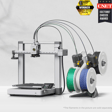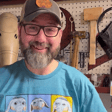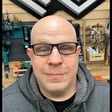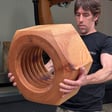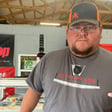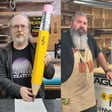Become a Creator today!Start creating today - Share your story with the world!
Start for free
00:00:00
00:00:01

2 Nick Berchtold
We talk to Nick Berchtold about his amazing cnc work, his shops full of tools, and of course perky breasts.
https://www.instagram.com/berchtolddesignbuild/
https://www.berchtolddesignbuild.com/
Things of the week:
Nick: Greg Blanpied https://www.instagram.com/greg.obj/
Al: Old VW Bugs
Jeff: Pressure washer pumpkin carving https://www.youtube.com/watch?v=n57NVVw_kHg
Patreon: http://patreon.com/digifabricators
Discord: https://discord.gg/hHp8Sv7vt4
Recommended
Transcript
00:00:12
Speaker
damn Hello and welcome to Digifabricators, the show where we learn how makers and artists use their computer-driven tools for fun, art, and profit. I'm your host, Jeff Stein, AKA a Weird Guy, and with me is my talented but humble co-host, Al Schult of New York Woodworks. How are you doing, Al? I'm doing wonderful, Jeff. It is a another beautiful early November day air in New York, had the doors open on the shop all day. It's been in the sixties and seventies all week. It's a good times. I've got 40 degrees here in Minnesota, but at least it was raining the other day instead of snowing. So I'm not going to complain. Yeah. All right. Let me read our disclaimer here before we get started.
00:01:05
Speaker
Even though we pretend to be experts on the internet, I would like to point out that neither of us have any actual training and are just guys winging it in our shops and learning as we go. All advice provided is based on our personal experience and possibly inaccurate assumptions, and it's worth exactly what you pay for it. If listening to this show causes you to take out a loan to buy new and expensive digital tools, you may tell your spouse that it was our fault, but do so at your own risk.
00:01:33
Speaker
All right. So today we are talking to one of the most talented CNC artists we could find. He does amazing work on a handful and three and four axis CNCs. He's done vases tables and tattoo chairs, but he's best known for his perky breasts. Welcome to the show. Nick from Birch told designs. Welcome aboard.
00:02:01
Speaker
Yeah. You know, if I've learned anything from watching clamp and hearing grant it, the introduction is really, it really makes a good show starter.
00:02:17
Speaker
So how are you doing? Doing well. The weather's great here in Chicago as well. Pretty mild. I like mild weather, but kind of scary, mild.
00:02:32
Speaker
Well, that's climate change for you. You don't know what change you're going to get. You don't know when it's going to change again, and you don't know what it's going to change to next. It's like ah mother nature is off of her anti-psychotics. So enjoy whatever's nice while it lasts.
00:02:51
Speaker
Yeah, for sure. For sure. Uh, Nick, I got to say, I don't know your, your, your epic beard there is a little darker than mine. So I'm not, I'm not sure what age generation I'm talking to, but, uh, scrolling through your, uh, your portfolio, if you will, I got to say, I felt like, uh, you know, the, the old Saturday night life's get tear, you know, we're not worthy. We're not worthy.
00:03:19
Speaker
you ah you have um You have an amazing amazing imagination and ability to pull it all off. And I'd really love to hear like what you're doing it with and how you're doing it. and For me, it's all about having fun, trying new things, always on. For me, it's always the most fun, to be honest. The next thing, the next best thing. Right now, I'm doing a lot of knives, so I'm learning.
00:03:49
Speaker
working with a a blacksmith outside of Chicago, wardrobe forge. So he's saying his name is Max. And Max has kind of shown me the ropes of getting into blacksmithing. He's got a whole blacksmithing shop. Are so are you forging blanks yourself or are are you buying blanks and and finishing them? A little bit of everything. So I guess at my shop,
00:04:12
Speaker
I guess something I've never shared online yet, but I have a Wazer water jet cutter. So we started. First thing was pounding out some steel. I went to high caliber camp with Austin Sanders, the high caliber craftsman. I brought my wife there and our goal was to forge a cleaver when we were there. So we did all that by hand with a hammer. And then I get back to Chicago and start posting some pictures of it and Mac reached out. So I went out to his shop and I forged out a couple more c cleavers.
00:04:39
Speaker
And then me and him, he, we were just like shooting the shit one day. And he's like, what's your ideal knife? And I pulled out, I've got a bench made pocket knife. And I'm like, I love this, but this is what I don't like. And this is what I don't like. And he's like, well, let's just make one. So he basically just took a piece of metal and started grinding it, worked out a knife blank, uh, kind of gave that to me. I took it to my shop.
00:05:04
Speaker
and then kind of photographed it, digitized it, cleaned up some lines, and then started designing handles for them. So then we started initially prototyping on my Wazer water jet cutter, which quickly realized it's cheaper to outsource that. The cost of abrasive to cut a knife blank at my cost is double what I would pay someone like water jet knives to cut one out for me, which is crazy. The abrasive in the water jet is expensive. Yeah.
00:05:34
Speaker
And it doesn't recycle? No, you got to throw it away. It's a one use thing. And you basically feed it in, it cuts through and it goes to a ah bucket almost. And you got to dump the bucket every so often. Wow, that's horrible. So I thought you were just like, you know, playground sand or whatever. And I think, well, I haven't tried anything else except what they recommend. And I know these things can clog up really easy and you can burn the tips out if you don't use the correct abrasive. So I've been using all Wazer abrasive and basically cost me $35 and abrasive material to cut a knife and I can order one steel included for $26. So wow. Yeah. See, that's it. Is it just, is it, do you think it's because the wazers are such, um,
00:06:22
Speaker
on the scale of water jets, they're pretty tiny. So they like, they need specific specialized abrasives or are they running $100 in the big machine to do what you're dealing with 30. Yeah. i'm I'm not sure. I haven't looked too much into abrasives. I haven't looked at all into other water jet cutters. I know the wazers pretty weak for what I want to do. At some point I'll get into the goal for that machine has always been kind of stained glass too. so I'm hoping it cuts glass a lot faster than it cuts like a hard ah hard metal. but even cutting aluminum I cut a couple pieces of aluminum just to test and that was still pretty slow too. It takes a long time to to pierce through the material so that uses a lot of abrasive to even just make a hole so it can start cutting and that takes a full like two minutes to get through an eighth inch piece of steel.
00:07:16
Speaker
ge in mine was the I've had the Wazer for years and years and years. Now we used it a little bit when I got it, but not for anything. um special just get it working and then we've never had use for it now I'm starting to do knives and just realizing it's not going to do what I want it to do. No production runs on this machine, strictly prototyping. And even for prototyping, it's just for speed. Like if I want a day of, I can cut it, but if I wait a week, it'll be literally cheaper. Right. Stained glass sounds interesting.
00:07:52
Speaker
Yeah, maybe that's something you'll have to get into one of these next new shiny things to try. Do I see a stained glass handle, stained glass handle come up?
00:08:05
Speaker
I think it was a laughing Mantis. I can't remember his name, uh, his actual name, but laughing Mantis on Instagram did a 3d stained glass lampshade. I think it was R2D2, the top of R2D2. And that just got my mind going like crazy. ah we not even I don't even want to start with a flat object. I want to go straight to 3d. Yeah, that was a heck of a cool lamp. I saw that.
00:08:32
Speaker
So we're gonna have a Tiffany level Darth Vader helmet. That would be I mean, yeah, I mean know as long as you want to design a model as like a fractal like a fractal model where they've got the you know, the the faceted Look to it then you could turn that into the pieces you need to cut out on the Wazer to Turn that into some 3d insanity
00:09:04
Speaker
Yeah, do it all the triangles. Yeah, it's pretty easy with Rhino. If I have a 3d model of something anyways, I can just reduce the mesh count till I can either program in how many facets I want or reduce it by certain percentages to get it. Just keep doing that and doing that and doing that until it looks right or feasible.
00:09:24
Speaker
So tell us about Rhino. That one's new to both of us, I believe. um I've heard of it. I've, I've heard of it. And the last time I heard you talk about it, I went and I looked up how much the damn thing costs. And that was the last I've heard and looked into it. So what's, what's that like compared to everything else?
00:09:47
Speaker
So I started, I guess, I'm an architect by trade. I make architecture models for a living, for a big firm in Chicago. So my schooling, we had to learn 3D modeling software. And we did we did that all on our own, like we didn't have classes on it, like they do with CAD and stuff, but 2D drawing stuff.
00:10:07
Speaker
So the first one I learned was SketchUp. And then as you guys probably know, there's a lot of limitations in SketchUp. And then the field of architecture kind of pushes Rhino on it. So every I'm on Rhino all day, every day for work. Every single team I work with, designs and draws, everything in Rhino. And then I get the Rhino files for those. So I run RhinoCam. That's my CAM software where you guys are running Vetrek or Spire.
00:10:33
Speaker
so But RhinoCam is directly integrated into Rhino, so any little chain like my 3D modeling software and my CAM software are all the same now, which is great because I've used always used Rhino as my 3D modeling software, but when I was at U of I, their CNC machines would run on master they were running everything through Mastercam.
00:10:54
Speaker
which is a great program, but a real pain in the ass if you're not designing in Mastercam. So any little change I would make to a file or any little error, I would notice it's like basically have to re-import things and re-code everything. So it's just a ah huge pain in the ass.
00:11:11
Speaker
so So it's a little bit more kind of like fusion that has the modeling built into the cam attached to it all in one big package, except the modeling's actually good in Rhino. Yeah. Right. I have not messed with fusion 360 very much, but there are some, there are some things that the office, the arch architecture office is asking me to do now that Rhino cam is not capable of doing. So we'll be looking into fusion 360 pretty soon.
00:11:42
Speaker
and we have three Fusion is great as long as you're not trying to scope realistic organic shapes. you know the the the The push-pull and blend and stuff are kind of lacking. um but i mean if you want It does everything that SketchUp does except much better because SketchUp never really and like actually understands a full 3D.
00:12:10
Speaker
quite right. um I tried SketchUp like a couple times, but I never really got it to click and I decided it was kind of crap and I moved on to Fusion. But yeah, I mean, Fusion's pretty good. It's got some decent modeling. It does really good in you know, objects that aren't super, I mean, I don't know that I could sculpt a realistically properly curved breast in it, you know, the organic shapes just aren't as good. But I mean, I can do, you know,
00:12:52
Speaker
inlays, SVGs, good normal, normal 3D things that involve boxes and cones and putting pieces together and revolving things and, you know, all the normal stuff does pretty well, but just not the organic shapes. Yeah, that was kind of the big upgrade from SketchUp too. It was getting into the more organic stuff and then everything in SketchUp is linear. So it's all made of lines. So even your circle is a hundred lines, but it's not perfect circle in rhino
00:13:23
Speaker
I think it's called NURBS. So it's NURBS modeling. So everything's like perfect. Perfect curves, perfect spheres, things like that. Not segmented. So modeling a NURBS instead of meshes. I got to learn some terminology.
00:13:41
Speaker
ah I don't even know what it means. I just know that that's what we use. yeah Yeah. Yeah. I'm sure you have no idea what you're doing. ah You don't strike me as that type of person.
00:13:57
Speaker
so what what do you have first how many How many shops have you got? you've You've got a shop of your own plus you've got the workshop. yeah it's like So I run ah a model shop for an architecture firm. So I've got a whole like set of tools of a certain size in there and a bunch of digital fabrication machines. And then in my personal shop, I've got a ah four foot by eight foot CNC machine and kind of more traditional, fine woodworking set up, a shaper, bigger table, saw, router table, things like that.
00:14:28
Speaker
ah winner Yeah, i've seen i've seen pictures of some of the stuff you've got at work and I I think you had a rotary you could stick a tree log on to Pretty much intact. So i'm running at work. I'm running a house tm1 with a four axis rotary platter um, that's a working with houses really expensive, but everything works right out of the box. Nothing ever fails. It's like like an industrial machine. over It's a low-end industrial machine compared to like a high-end consumer machine. But the thing's built like a tank. You can't break it. Whenever I started, they didn't have the four-axis part of it. So I expect all that and install all that. So I learned that from kind of the ground up, doing it on my own.
00:15:21
Speaker
And Haas told me the one that I ordered wouldn't even fit on the machine. And then I had to call and argue with him like, no, I want, I want the 12 inch one. I don't want a six. inch one that lift up i just want the big twelve inch platter and they're like Well, it doesn't work. you You can't do this. You can't do that. And I'm like, well, the gearbox is off the side. So if we mounted on this side only, we we should be fine. It all worked out. So that's right let me, let me tell you how to build your machine. like We want to do very, like at that time we were doing basically, they weren't logs, but they were log size, uh, four axis carbs for like stacking stools. Like things that I do for work that they have never been, uh,
00:16:02
Speaker
publicize, they've never been online. But that's what we got the, that's what we were getting the machine for. So we needed to go big. Right. Everything before that was we've gotten six sided segment things and flips and nothing ever quite lines up perfectly. So the Forex has changed all that around for us.
00:16:22
Speaker
Right. Yeah. ah Turning four-sided carving on a three-axis machine is a challenge. I'll acknowledge that. So we've have've been there and we got, we would go really crazy with it. So we do these towers, the architecture office I work for primarily, super tall skyscrapers.
00:16:47
Speaker
So we're doing all these, when I started, we're doing all these geometric shapes of faceted buildings. So it'd have like 12 different sides and we would have to do flips of six. So I basically cut a hexagon in my stock and then I would mill out a negative hexagon and clamp it down the same way you did your, your five, five sided carbs, but six rotations instead of six sides. And then you don't do the top. Right. The top was really the.
00:17:16
Speaker
the the worst of it. That was some weird one. But yeah, I mean, you can rotate as many angles as you need, as long as you can fixture it and pivot accordingly.
00:17:30
Speaker
so Rotary is a lot easier. Yeah, rotary is a lot easier.
00:17:37
Speaker
Do you have rotary in your, in your personal shop as well? Yeah. So it's where you do the handles and stuff. Yep. So we haven't, I've got a, an eight foot long attachment for my cam master or stinger. We haven't done anything that big yet, but.
00:17:51
Speaker
I did at one point have a guy reach out, I think from North Carolina to do big titty pillars on the front of his house. And I think my quote, I probably over quoted him for it, but he's like, I need 10 foot tall titty totem poles and this and that. And I'm like, I have the machine to do it, but it's going to cost this much to do it. And he never said go.
00:18:12
Speaker
Not to mention the hassle of putting those boobs in a box and getting them there in one piece. Oh, I'd have to bring those out. I'd want to see those put in place. yeah You'd have to drive it down there and install them yourself. Yeah. and in so I'll watch someone else install them. Oh, okay.
00:18:30
Speaker
Now I was watching one of your videos and you have a, you have a rotary like similar to, uh, Jeff, but it had a, it looked like it had a, um, a slide off of a, uh, a mill machine. And is that, is that is also controlled? I'm not sure what you mean. got you You got your rotary.
00:18:57
Speaker
but then your table was moving and your gantry. The, the host is a vertical milling machine. So the Z stays stationary and then the table moves to the cutting. I'm sorry. Thank you for clarifying. No, I would love to get into it more access milling machines, five and six. I don't even know what the sixth is.
00:19:26
Speaker
I know where five is. They just keep adding. yeah They just, they just put something that moves on top of something that already moves on top of something that already moves is basically right. Yeah. So we call the, the big, the big robot arms would be a six axis. Cause you're actually capable of milling six sides of a cube. Okay. So you can get it like five axis. You can't get that bottom face, but on six axis with a robot, you can come up and up and under.
00:19:53
Speaker
That's what we were talking last week. And he, I believe that was your thing of the week, wasn't it? No, it was my dream tool. A dream tool. I'm sorry. Yeah. Yeah. It was my dream tools to have one of those robot arms. Yeah. Decent sized when I can bolt down in the corner of my shop down here and a bunch of attachments, you know, that's been my longstanding answer to that question is what would you get if money wasn't an object and like a $2 million robot arm? Is that what they are? $2 million?
00:20:23
Speaker
The want one that I would want would be $2 million. dollars i hey Again, like if money was no object, I would want one that's substantial and basically the size of a like the size of a shop. So I would want to mount this thing in the middle and be able to do everything all around it. Have you ever seen lignum? Yep. Yeah. they've They've got two of those things and then and no table, the Eustantians.
00:20:52
Speaker
so like the The fixture is floating, basically. Aaron Poritz has got one. I've been watching him for a few years. Eli Wood Designs has one. I've got my eyes on some. I just have one. I don't have a good one right now, and two, trying to find funding for it. Yeah. Yeah. Yeah. There's, there's a, honey, I bought a tool and then there's Uh, honey, I mortgage the house and, uh, your, your insurance policy and, uh, yeah, sorry. and that and that And that turns into, Hey Jeff, whatever happened to Nick?
00:21:39
Speaker
ah Well, you know, I said you, you can blame us for buying tools, but do it at your own risk. mr That's, that's your risk right there is, uh,
00:21:49
Speaker
Your spouse may not care whose fault it is. But ah we've worked through the architecture office. I've worked with a stone carving company out of Madison, Wisconsin, Quora. And they they carve some solid marble pieces for our furniture line at work that never got launched. but So I've got one of those pieces at home, but that's kind of the machine that would be speckin'.
00:22:14
Speaker
That's pretty cool. To be able to do stone, wood, metal, anything. Be able to attach a MIG torch and do additive metal manufacturing. Geez. Yeah. That's a Swiss Army toy. But then programming would be a, I don't even know how steep that learning curve. The learning curve to get to where I'm at now is pretty steep. I don't even want to know how how much steeper that gets to program one of those.
00:22:39
Speaker
Yeah. Yeah, I guess. That's got to be crazy. Either that or the software has to be absolutely phenomenal. That it just, I mean, you can feed it the model and tell it what you want it to do and how you're going to hold it. And maybe it sorts the rest of the details out for you. Yeah. I'm waiting for AI to catch up to 3D and 3D programming. So I'm sure it's coming.
00:23:06
Speaker
I'm waiting for AI to catch up to 3D modeling. I've seen one AI that says it does 3D modeling, but you have to choose an object from the dropdown. You can have a dresser or a chair or I don't remember. There was about four things on the list and it they kind of sucked. But hey, I mean, first steps, you know, baby baby steps are there and maybe They'll make an AI that trains the next AI to actually do it right and tell them, I want a good detailed 3D model of a double D and see what it gives you. Right now it's an Energizer or Durasil.
00:23:53
Speaker
i you know I love those ah titty vases you've got where the boobs go all the way up the front of the vase, but every time they spin around, it's like, why isn't there an ass on the bottom of that vase on the other side? I just felt like it needs that. The ones I just posted have them. Do they? Yeah. Jesus, how did I miss that? It's a stylized vertical ass crack, but it's in there. Okay.
00:24:24
Speaker
All right. I'm absolutely okay. I'm not everybody. you're Not everybody's got a badonkadonk. So so that that's a big comment too. Do all the titties when you're going to do all the ass stuff? And I don't know. Titties are the comfort zone right now still. Well, yeah, I won't argue. and I mean, everybody likes boobs. I mean, that's been my argument.
00:24:54
Speaker
I mean, even chicks think boobs are cool. they they've They've got the advantage of being able to squeeze their own. i mean yeah from Well, I'm 300 pounds. I can squeeze my own too. well there go Hey, yeah you get what you get, man. there's ah that That's your silver lining right there.
00:25:18
Speaker
yeah yeah I appreciate your efforts towards weight loss, but are you going to miss those? I will not.
00:25:33
Speaker
No. ah So what other kind of a computer controlled assisted equipment are you running in your daily day?
00:25:46
Speaker
So day to day, CNC milling, three and four axis right now. We've got a c o two a universal CO2 laser, two foot by four foot. I've got one of Corey Stanley's Odyssey rotaries. I still haven't used it, but it's in the shop. Oh, boy. We got the water jet cutter that we talked about. We've got a couple Stratas' FDM 3D printers. I just got the office to buy five Bamboo X1 carbons, which are outperforming the Stratas' right now. cheaper Cheaper to use, and they print way faster, and the quality is pretty comparable.
00:26:26
Speaker
I've got, we run a vacuum forming machine. So those is basically milling high heat resistant polyurethane resin on the CNC to make molds. And then I can i can pull vacuum forms with that. got In the Chicago, downtown Chicago shop, the model shop, a full but condensed woodworking shop. So 12 inch planer, full size cabinet, saw stop, router table band saw, bell grinders.
00:26:56
Speaker
We've got to get creative with how we use those tools. So I've got like a whole tool docking system for benchtop tools that I can pull out and put in, scroll saw, little things like that, belt disc combo sander. And I just got a fiber laser from Luke in the garage gave me his fiber laser. So I've been starting to dabble with that. It's a 30 watt Mon port. Yep. Nice. Nice. I mean, recently, recently dove into fibers.
00:27:26
Speaker
And, uh, I'm sure you'll already surprised me, but, uh, yeah, there are a lot of fun. I was actually engraving some brass today for, uh, some hunters.
00:27:38
Speaker
And, uh, they get really excited when you, oh yeah, I can wrap that right around that bullet for you. No way yeah oh yeah way. yep Say my, my, my, uh, from Luke came with a little rotary attachment with it, but I have not had a chance to play with that yet. Everything so far has just been 2d. Have you been doing any 3d engravings? I have. Yeah. Some brass coins, but I went on Amazon and just bought a box of them. Um, it's a, yeah, it's a learning curve.
00:28:07
Speaker
And it's a, and you'll even, mine's a 50 watt and I'm already wishing I bought the hundred, you know, but, um, I can say what limited experience I have. Fiber lasers don't care about power. Power just equals time. So the quality off a 30 watt and a 50 watt and a hundred watt at the finish point is exactly the same.
00:28:36
Speaker
And so it's just, it's just a matter of how long, but like, yeah, I did a, I did an alligator. Yeah. I did an alligator 3d coin and it was two hours.
00:28:51
Speaker
That's what awesome Austin was telling me. I was talking to Austin and Keith a little bit about theirs, and they're getting into the 3D carvings now. They're like, how do you generate files like this? And I'm like, I don't know. I just got one. like I haven't messed with it at all, but it looks like basically grayscale maps. Are you generating your own or are you working with pre-made files? Yeah, just pre-buy them.
00:29:14
Speaker
But the grayscale, there's basically 256 shades of gray and grayscale. So you're going to make 256 cuts passes. That's all it was. I was engraving just the blade steel on the knives that we were doing to do it on a high, high carb steel. It was like 200 passes to be able to get a ah thumbnail on it. Yeah. Yeah. Yeah.
00:29:39
Speaker
I'm sure my settings are nowhere near optimal because this was the first, these are the first things I've ever done. That frequency makes all the difference on how deep your penetration is. So whatever your frequency, I think the higher frequency, no, lower frequency is deeper cut, higher frequency is for cleaning.
00:30:00
Speaker
Yeah, kind of. I mean, we'll get it that way, you know? Yeah. I mean, for what the machines are, there there are no tutorials. No. you only So it's just me. I haven't even done like the tiles where you cut different feeds and speeds and everything. I'm just basically Googling or YouTubing how people get brass black. And then I try to mimic their settings with my machine and max the power out.
00:30:28
Speaker
Definitely learn learn a little bits about it every day. yeah Yeah Every time you hit send you go, huh? Let me make a note of that And the thing says what happens if I push that button Mm-hmm. I keep a I keep a field notes by the co2 laser. I keep a field notes by the fiber laser and I keep a ah field notes on the CNC so of something some weird thing or a change or a setting and Or something works. Write it down. I've got a stack of Post-its right by the the CNC machine. yeah My CO2 laser I've been using for 15 years now. and And all of those are up here. yeah Every setting for every material is in my head. So I can manually program that off the cuff.
00:31:21
Speaker
I haven't gotten any of these fun lasers yet. I'm just sitting here playing with a diode. And I'm not even really using it, but it's, you know, something to play. Diodes are pretty nasty at very low Watts. Yeah. Well, I dunno, with four and a half Watts, I can, you know, I can engrave pretty much anything and and and in a few passes, but you can get like eighth inch ply boards that you can feed it and.
00:31:55
Speaker
It takes, I don't know, 40, 50 passes to cut through that stuff. You're sitting there for 20 minutes trying to cut a small design out of eighth inch ply. It's just around and around and around it goes. It's like, Oh my yeah. It's just like the other lasers, you know, it'll get there. yeah It's just going to get there a lot slower because I've only got four and a half Watts to play with. Right.
00:32:25
Speaker
It is what it is, but I never really seen a value for me to have a, like a CO2 in my shop. I've not had the kind of production or anything that I would need to cut pieces out with that. I, you know, I can either do it on the CNC and an entire night instead of, you know,
00:32:52
Speaker
uh, rushing through it on the CO2 in 10 minutes. I'm not in a hurry, I guess. and I just don't need it in my workflow, but I'd sure like one of those fibers. Cause I think it'd be fun to be able to put, uh, you know, engravings on metal and anything you stick into it. It's just gotta be fun.
00:33:16
Speaker
it's a Yeah, it is. It really is, Jeff. You don't know what you're missing, bud. Now you're going to get your ah your guests to convince you to spend all this money. Yeah, there you go. Yeah, exactly. It's it's not like I haven't looked. I mean, I went and I saw all of these laser packer things look cheap, and then I realized that the cheap ones are actually just diode lasers, and you have to scale up to the expensive ones before it actually you're you're still up to like $1,200 by the time you get one that'll actually engraved metal properly. Like I thought that that, you know, they made it sound like laser peckers are all like, Oh, we can engrave metal with those. Yeah. The expensive one you can. I thought I could get one of these little cheapos and it would just take twice as long, but no, it's not doing it at all.
00:34:11
Speaker
Yeah, I went down the same rabbit hole. So I was looking to buy, I was looking to just buy one because I wanted one to play because they just look fun to me. And now they seem to be popping up more and more. So I'm like, maybe I need to get my hands on one of these and dove into the same thing you did. I'm like, Oh, they engraved metal. They're only like 800 bucks. Like, yeah, I'll just buy. Nope. You dig in and every little thing costs a little bit more. And then Luke had one that he wasn't using and he offered it up for sale and we worked out a deal and I got his. I think his was like $3,000 or $4,000 anyways and that's a a weak one.
00:34:51
Speaker
We need to talk. I need to talk with someone at Montport about tutorials or speed settings and feeds and just some kind of. What are you using for software? So they they had you download EasyCAD and that was a dog shift program. I struggled with it for a few hours. and I'm like, I got to buy Lightburn. So then I'm still using the Lightburn trial right now, but I'll end up buying Lightburn.
00:35:20
Speaker
way better. you couldn't it' The same with the Wazer, by the way, is their software is just absolute shit. You can't. I wanted to ask you what they used. they use It's called WAM. It's their own software. But like if you're going to take CAD and dumb it down to the point where you can't reference anything else, like and I couldn't even split up cut files. like I'm bringing in a knife point that's got three cuts on it, three internal, one external, and I can't program it to cut the internal ones first. It automatically So that's the ones that it wants to cut and how it does it. And it's just like, I need more options. Just let me, yeah let me program it out of CAD or Rhino or something like I do with the laser cutters. And I can locate everything where I want it. I can cut test pieces and scrap material and do all this other stuff that you're just not allowed to do with it. It kind of beyond me as to why they wouldn't want a precision element or precision software for precision machines that they're making
00:36:15
Speaker
Even the fiber laser was a nightmare to even set up and zero out and offsets of all that stuff. Because it doesn't come loaded to just cut something. Like say I loaded it in the center of the piece, it's not necessarily a cut in the center of the piece. You have to dial all that in. The way you do that is just kind of, in my opinion, very dumb. I got to drop down one file format.
00:36:44
Speaker
change a parameter and then I close that out and test cut and I got to do it all and I can't just do it all in real time. It's back and forth and back and forth. But now it's pretty close to dial in. I wouldn't say it's it's perfect by any means, but I'm not trying to perfectly center things and other things yet. So but I'm sure there'll be fixture plates and stuff where fiber out or just laser out of pocket for a coin to sit and I know it's exactly centered and
00:37:15
Speaker
That is an annoyance when they, uh, that is so annoying when, when, when you get a tool and you can only use their damn software to run it, especially when there's an industry standard that everybody likes that works much better. Um, the, the, the Wazer was like that my, uh, my, uh, resin printer that I had a Mars two pro for a few years, you could only use their slicer program with it.
00:37:45
Speaker
There was like one, i there was supposed to be a second slicer that worked, but I never got it to connect and function for it. It was like I had the one piece of software and it wasn't a, and it wasn't one of the popular slicers that everybody knows how to use and cares about. There's some weird crap. It was just, I don't know why you wouldn't make your, so your hardware.
00:38:11
Speaker
capable to be spoken to by normal shit. I mean, go ahead, put out your own software if you want to, but it doesn't mean you have to block other software from being able to connect to it. ah Proprietary shit's just annoying. i' love with you Laguna did it. they're They're like, yeah, we don't need software. Who wants to sponsor us, basically. And Vetric said, we will.
00:38:39
Speaker
So so lagoona sells metric software Yeah Yeah, but I mean you could create a path from anything and send it Sure. Yeah versus, you know with the mars program. I I had to use the mars program I don't remember what the hell it was called, but I had to use that specific software To slice my model to print it do it and I couldn't use industry standard for everybody else's favorite slicing program that has all these extra cool features in it because they didn't have those features. I just didn't get it. And it's like, you're not being able to do Wazer soft, you know, Wazer programming, like a decent human being, like using light burn. You got to use their crap that is, you know, substandard and mandatory. Yeah.
00:39:34
Speaker
No other options for that machine, but it is what it is. Yeah. Well, I suppose that's life. It's life with our digital tools, man. We got to have digital gripes, right? Yeah. Isn't, uh, there's a lot of like, uh, go for it. Don't they have their own proprietary? They do. I've never had one, but yeah, they have their own system, I think.
00:40:04
Speaker
And it's also annoying because you can't use it unless it's online. Yeah. Yeah. Yeah. I know you. The only way you can do it is to send it from their software through their server and back down to their hardware in your room. That is, I guess that's Wazer too. Cause that's why I'm as online as it, oh yeah okay. Not even a program you download, but then you got to get online, generate your files and then export those to an SD that you plug into the Wazer.
00:40:36
Speaker
Okay. That makes sense. I mean, um, I suppose technically the bamboo came with its own software. I don't know if you have to use the bamboo software or not. I not sure, but I mean, it seemed, it seems to break an exception for me here that I don't feel constrained by using the software that came with it because it's,
00:41:04
Speaker
better than the other software because it does the painting and the coloring and the other stuff that you want to do with the bamboo because you've got the AMS multicolor options. And, you know, the the other softwares that people use for their slicers don't have color painting options. So I haven't wanted to use a different software than the bamboo apps because It does all the extra shit that the hardware does. So how do you, how do you excuse me for interrupting, but sure these color changings, like when you send, when you see 3d objects printed in two or three different colors.
00:41:48
Speaker
how How is this doing? I mean, I understand the concept of the layer. So is it changing colors per layer? Yeah. So it has it still has to do all of layer three before it can start layer four. So if there's areas on layer three that have multiple colors, it'll print the blue on layer three, and then it'll do like a two minute color change.
00:42:18
Speaker
where it cuts the filament right behind the print head and then sucks it, rolls it right back up onto the spool and then feeds the next color of red down in through the thing and into the back of the print head. And then it moves over to the back corner where it's got a little trash chute And it pushes, phil it pushes, it runs, you know, a few inches of filament through the print head to flush out the rest of the old color. And then it wipes it off and poops that out the back of the poop shoot in a little plastic knot kind of, and then it, uh,
00:43:09
Speaker
wipes the tip off and then it goes and it does the red from layer three. And then it'll go do the red for layer four and then switch back to blue to do the layer four blue part. Um. This sounds like a very, very time consuming thing. Yeah. Yeah. I mean, considering bamboo is a very quick printer, you could, you could just print a model in say an hour, a decent size model in an hour.
00:43:37
Speaker
Or you could print that same model in two or three colors in six and a half hours. Because there's two minutes for for every level that it needs is to change colors adds an extra two, two and a half minutes on there while it squirts out the other stuff. And because, I mean, you don't want to blend of the colors with any of the last color remaining. You want to you want to definitely flush the previous color, so it just takes all that extra effort. It's not a huge amount of filament waste by weight, but it sure makes a big pile of poop behind your machine. But um that's also a reason why people print multiples of things if they can. Because if you've got, ah ah say, for example, I mailed you an F-bomb,
00:44:35
Speaker
and ah if I print and if I print one f-bomb it might take ah you know three or four hours because of the fact that it's got to switch back and forth between the colors back and forth a number of times but I could print six of them and it It has to print six, six times as much plastic, but it still has the exact number of color changes that it had before. And that takes 80% of the work. So you can waste four hours on color switching and then have yeah you print one model that takes an hour plus four hours. The color switching is a five hour run.
00:45:29
Speaker
four hours of which are wasted. If you print two of them, it's now going to take six hours where you've got two hours of printing and four hours of switching. So the more pieces you put on there, if you print like eight or 10 at a time, then you're dividing the four hours of wasted time by the number of pieces you get for how much wasted time you made for each one.
00:45:55
Speaker
So you kind of can recoup some of that time by getting your money worth out of every color change. Is it, you know, if you're going to print 10 of them at a time, it prints all 10 of them for layer three, and then it does the switch once. And then it prints all 10 of them for the next color. So it's going to waste four hours, but your amount of waste per part.
00:46:25
Speaker
Drops drastically. Yeah. It's like repeatability on a CNC, you know, just being efficient, cutting the same thing over and over and over and over. yeah And then make the tool change and then cut more pieces. Right. That's how I would relate it. You know, if you could lay out 10 of them on that four by eight bed and get them successfully, you know, fixed, you're down and held. Of course you get vacuum, but, uh, if you laid 10 of them out,
00:46:54
Speaker
and then had it run the big bit on all 10 of the parts and then did one tool change and then did all 10 of them with the next. That's, that's the equivalent to doing the color changes. Except you got a color change for every single layer all the way up. It's really pretty interesting how the majority of these, these digitally controlled machines are kind of doing the same thing. You know, it's all,
00:47:24
Speaker
It may not be a gantry, it might be a spool, it may not be a but the controls and the concepts are similar. you know A tool change versus a color change. Layers versus... you know uh, Fixturing on everything. Right. Fixturing is the bane of our existence. That's where to get back to Jeff's thing with the laser in the shop. It's like, I use a laser cutter for speed for me. If I need to cut 2d parts, I don't have to fix your anything down. I just put a piece of material in there. No clamps, no nothing. It cuts the parts out and I get it and go gravity takes care of it with the laser. That's nice.
00:48:05
Speaker
that that maybe there's And prep and Everything's flat on the bottom and you gotta figure out either clamp it or screw it down or vice it down Laser you just pop it in and let it go Yeah, that's that's super nice Actually fixturing is why my bamboo is down at the moment is I had a part fall off the bed and then it somehow managed to wrap itself around the print head. And then it clogged it, it blocked it from going anywhere. And it, an hour later, it had like an inch and a half, maybe two inch across blob of plastic surrounding the entire print head. And, uh, that was fantastic until I broke the, uh, what do they call it? A thermistor.
00:48:59
Speaker
is like the the little thermostat on the heat sensor. I broke one of the wires off the thermistor trying to retrieve my print head from inside a glob of melted plastic. So I'm down pending USPS delivery the beginning of next week. And it's because fixturing failed me. The part fell off the bed. Maybe I should have used glue.
00:49:25
Speaker
So far, I haven't had to use glue. Everything has just stuck. I use a textured plate for everything, but everything so far has stuck to it. Just and make sure you keep the textured plate super clean. And if you're going to print anything that is like really wide and thin that You turn the temperature on the bed up like five or 10 degrees. It'll stick down a little better because the thin flat the like The thin flat parts are the ones that want to peel up on the corners as they cool down a little bit So I understand if you want to get by without the glue adding an extra 10 celsius on the bed temperature is good for helping that But apparently I did not clean the bed off
00:50:14
Speaker
Uh, the text, the textured plate probably had some residue left from whatever I printed on it last and, uh, shit went downhill from there. And, uh, uh, you know, I give X one credit for the, uh, spaghetti detection system. Cause I mean, that's, I think that's one of the things you get when you buy the X one instead of the P one models is it comes with the extra.
00:50:43
Speaker
CPU that's got the AI spaghetti detection. And it'll recognize that there's spaghetti happening down there and it'll pause the machine and send you an alert and say, uh, you might want to check this and then let me know if you want me to resume or cancel, which is fantastic.
00:51:03
Speaker
but apparently two inch diameter blob of solid plastic or surrounding the head did not look like spaghetti to the AI system. But I do appreciate it when it does catch that crap. It's only it's only done me wrong so far.
00:51:23
Speaker
the little boost will go on the bed and it'll detect spaghetti. And the 3d printer is a ah shop two miles away. So oh now there is no problem, but it thinks there's a problem. So it pauses it and then I lose a whole night's worth of printing. Well, assuming it actually notifies you, because I mean, if, if you're signed into it and have the bamboo app on your phone,
00:51:49
Speaker
it'll actually send you, it'll it'll give you a notification on your phone that your printer's fucking up down there and you can actually pull up the camera and look at it right there on the phone app. And if it's just a plastic poop that fell out of the chute onto the plate and it's not in the way, you just push the damn resume button and it goes back to business as usual.
00:52:16
Speaker
but you have to have that on the phone and you have to get lucky that the server actually notifies you about it, which is ah not a hundred percent. yeah I've done that, but it, I don't know if the spook, the little poop thing moves as the machine moves and then I get the air again until I get off the bed. Yeah. Well, thankfully I'm just downstairs usually not, uh, but I mean, I have been, you know, off,
00:52:44
Speaker
you know, driving across the countryside a couple hours away before when my shit went south. But usually when that happens, it is situation. I just need to hit the stop button and I'll worry about starting things back up again when I get home. eight Can those things destroy themselves? Like, you know, you hear people like don't ever leave a CNC machine alone by itself. Like, can you walk away from a 3d printer and what? Yeah. i Have a problem.
00:53:14
Speaker
Oh yeah. I've been running them 24 hours a day for the past 15 years. Yeah. You, you can come back to problems. You can come back to hours worth of spaghetti all over the place or big melted blobs or, you know, I mean, it can crash into things, I guess. And, you know, but ah none of those things are like the laser where.
00:53:41
Speaker
it's going to catch your entire shop on fire if you're not paying attention. The the the printer, when it screws up, is the damage is limited to whatever damage it does to itself and the part you are working on. There's not any concerns where, you know, the CNC can start a fire. The lasers can absolutely burn your shop down. The printer can break.
00:54:11
Speaker
It's, you know, it's not as serious of a problem. So you can kind of leave it unattended and mess off and come back and hope things worked out. Yeah. Yeah. It can still screw up. It's just not as serious of an issue when it does. Yeah. There's no fire involved.
00:54:31
Speaker
I mean, CNCs usually don't have fire, but I tell you, I see a little. Spirky go flying off of my carbide bits from time to time. So I can see i've laid every CNC machine I've ever used on fire. So yeah,
00:54:48
Speaker
I. i've heard people ah I've heard people have fires in their dust collector bins before where just you know they got some some something started smoking and some embers went flying up the dust collector and landed in with all that fine powder dust.
00:55:05
Speaker
say It never got that bad for me, but i I was doing things that I shouldn't be doing with it. I was drilling holes. I had a couple of holes to drill, so I was just like, I'm going to drill them with an end mill. It'll be fine. That's not fine. Don't do that. But there was a it was running on a vacuum bed, and there was a fire below. my The spoil board was on fire, but I couldn't see it. And I could smell it because ah the exhaust was coming out of the vacuum pumps.
00:55:33
Speaker
And I was just like, there's a fire, but there's no fire. There's no smoke. The dust collection was smoked with sucking up all the smoke. The vacuum was sucking out all the smoke from down there. So I had to shut the whole thing down, pull the work surface off. And there was just embers on the spoil board, getting all of the fumes and all of the smoke sucked out. So that could have been bad. Luckily, there was just a little patch on the spoil board for me. Right. Well, you smelled it. Yeah. At U of I.
00:56:02
Speaker
they never had money in the budget to buy anything new. So we were cutting with dull router bits, taking things out. And we're cutting some old shitty plywood with dull router bits and that generated enough friction to start fire on that material. I did some inlay, some aluminum inlays and a piece of walnut. And then I wanted to 3D mill that down and the aluminum got so hot, it lit the walnut on fire. Cause I wasn't lubing-ish cause I didn't want the lube on the wood.
00:56:33
Speaker
Little things you pick up from along the way. I messed up a zero from top from spoilboard surface to top of work surface and put a quarter inch end mill right through the vacuum bed and and just burned a donut hole with the collet right into the spoilboard. ah Oh yeah, I mean it's it's one thing when you dive the bit through the spoil board. It's a whole and nother level of fun when you push the collet nut down into the spoil board. That's when you really know shit's gone wrong. I'd say luckily on the Haas the four axis platter is so far to the side that the Z axis gantry can never even hit it. so
00:57:24
Speaker
Those are like collision things on other machines, but we've made it so it cannot be a collision thing on mine. But you can, and I have dozens of times is rotate your stock right into not lifting your Z up when you're doing the rotations. So you get those not fires, but a lot of broke, or I've had a lot of broken bits that way. I worked on a gun stroke one in the intro.
00:57:52
Speaker
I worked at a gun shop for a few months before I got my architecture job. and they give us when I was a programmer, so I had like my own machine, but then I was programming six or 12 other machines, and I would have to go through and zero them, so they gave us like this $400 zeroing fixture plate. Day two, probably, I ran a tool, just switched that dial the wrong direction, two clicks, and busted that caliper real good.
00:58:22
Speaker
hope please said they gets you We're going to give, we give everybody one and then you got to buy the next one. so They let me off easy. You don't tend to make, uh, mistakes then as much either. Well, that's the other thing, uh, with 3d printing on the, we've been using stratuses for 15 years now too. And it's when you get problems of the gumming up on a bamboo, the, even if you had to buy a new extruder head, that's under a hundred dollars for the, for the statuses, it's two grand.
00:58:56
Speaker
Ouch. So those were, and those have lifetimes on them. Like you can only print for like 1500 or recommended only printing 1500 hours or something. So they really get out or that whole industry was a gallery. Corporations of companies for years and years and years and years still are. I got a call from Stratas is a couple of weeks ago. I'm like, why aren't you ordering it? You haven't ordered any filament in a while and this and that. I'm like,
00:59:24
Speaker
I got five, $1,200 machines that are outperforming this $80,000 machine. we but we We're not going to order any more film. Nope. I don't want anything else from you either. No, that's, that's crazy. I mean, I think Bamboo wanted, might've been $14 for just the print head, but I think it was like 35. I got the full assembly. It's got the, uh,
00:59:54
Speaker
the the heater and the thermostat thing and the clip and the boot and the fan and the whole nine yards on it for like 35 bucks. And, you know, when they send you a printer, they give you a spare print head. It's just, unfortunately, the print head's not the part I broke. It was the thermostat. They don't give you one of those. So, oh well. But yeah, affordable parts are nice.
01:00:23
Speaker
a couple thousand dollars for a print head and you have to change them regularly. Yikes. That's, that's not a, model that that's only a model you can sustain when there's no real good competition in the market.
01:00:38
Speaker
Well, even then, you're not for us, like we're not sending 3D printed stuff to clients. like Those will be milled or laser cut or something fancy. We use a 3D printer for study models, for context models, for things that don't really get shown to clients. So it's really hard. Now, at the point with the bamboos, it's like really hard to justify anything on that machine. But for the longest time, it was a battle anyways, because it's like we're not we're not getting production quality parts off of the, we're getting trinkets basically off of these machines. It's not for the industry I'm in. Like those just don't, that stuff isn't good enough to go to clients. So right. It's an $80,000 key chain printer. Yeah. Well, it's, it's, it's, it's not this year's or last year's technology really. I mean, I did,
01:01:38
Speaker
So are you getting the, the, what is it the 0.2 millimeter nozzles for your bamboos? So far I've just run the 0.4s. So we have problems. We don't do the detailed stuff with it either. Um, just don't, we just don't. So, but I mean, the, the layer heights and the smoothness quality on these things, even with the 0.4 nozzle is just, I've not seeing the money
01:02:09
Speaker
i'm not seen any reason to throw any money at a point too. I haven't needed that. i mean I know people that do and they need it, but not not for anything I've printed. say For me, I ordered all of the nozzles for all of the machines. I just ordered one of everything. i could get when i ordered the machine It wasn't my money anyways, but. Right. Yeah. all the party
01:02:40
Speaker
yeah So far we haven't changed any of them. They're all just run on what they came with factory settings. We don't even run them really. I haven't even run mine in sport mode yet. So just the regular mode prints fast enough for what I need to do.
01:02:57
Speaker
I've I've done sport a few times and I think I tried uh What's the ridiculous one ludicrous speed? I think there's ludicrous speed too is I mean normally it prints fast, but then there's like a What is it a 1.25 speed is sport mode and then 1.5 speed is ludicrous I've done Ludacris like once or twice, just really to see how it went and how it did. And I mean, it it does lower the print quality just a notch, but I mean, if you're doing a.
01:03:36
Speaker
prototype on something and the quality doesn't matter and you want it right now, it'll do it. But that thing is whipping around in there so damn hard. It really scares me that, you know, every minute I spend in ludicrous mode is just taking an hour of wear and tear on the machine.
01:03:57
Speaker
I might not be right, but it sure feels like it's beating the hell out of itself whipping around in there. And and it just kind of scares me as to, you know, what that's going to do to the longevity of all the motion parts. But. And they said, oh, I've heard that the machines will walk right off your table too. Yeah. I don't know. It moves so much and so fast, the machine moves.
01:04:22
Speaker
and start dancing off the front. Now the the reason it can get away with that is because it's it's smart enough to recognize its own motion and move the ah motors to counteract the motion of the machine. So if if you walk up and shake the table or bump the machine,
01:04:47
Speaker
It doesn't screw anything up because it's got the motion centers and it'll counter that. I know a guy that spent a year in one of those van living situations. And he had just a little bit of square footage left inside of that van. And he had to choose between having a portable bathroom.
01:05:12
Speaker
or a bamboo printer. and Surprisingly enough, his wife agreed to go with the bamboo. and He would print going down the highway with the thing printing over there and you bumping and swaying and print beautiful.
01:05:32
Speaker
so That that's why it can move so hard that it shakes the table is because it's compensating for its own shaking That's why because I mean that's why other printers can't move that fast is because they shake that fast They lose track of you know where they are on the plate But because it's got the motion compensation crap built into it Then it can shake itself right off the fucking table and not lose track of where it's at so
01:06:04
Speaker
That's just another one of those examples of where bamboo has really kind of pushed some of the technology forward on some things. I mean, I'm starting to see some other printers come out that do color switching and, uh, you know, some, I can't remember. I saw something at the other day. I don't remember what it was. It was supposed to be, you know, bamboo quality and maybe a cheaper version of it, but, uh,
01:06:32
Speaker
You know, we'll just wait and see how the lawsuits all settle out just like everything else. Yeah, still still trying to stay on top. Yeah, well, you know, Bamboo's got a couple lawsuits already. um um The one I'm sure of they've got isn't even a hardware. It's a software feature that they've got baked into the software that somebody else apparently copyrighted. um When it does the color switching, after it poops in the back and then it it like clunks the nozzle across the little ah nozzle wiper just to knock the poop off.
01:07:17
Speaker
And then it does something that it it calls a tower, I believe. And it just it just prints this little tiny square tower in the corner. So for every layer and every color, it adds just a little framework grid of the new color. and The point of this is is that the flushing in the back cleans out the inside of the tool head, but running back and forth and creating the little tiny tower in the back corner actually wipes off the outside of the nozzle for any remnants of the old color.
01:07:59
Speaker
and The bamboo software is trained to create the towers when it makes the g-code when any time it needs to do a color switch. And apparently somebody else has got a patent on that technology. So there is a ah lawsuit pending. I don't expect to ever affect the function of the bamboo. I just expect bamboo is going to have to settle and pay these guys some money for using their shit.
01:08:33
Speaker
Is it Stratus? Yeah, it does that on the machine. The machine, most of the, all our machines are dual extruders, so you have a model material and a support material. Okay. And it does the same thing. When it switches back and forth from them, it prints a little, on the Stratus, it's a dovetail key, basically shape. Okay. Okay. So it's their technology, bamboo stole. Yeah.
01:08:59
Speaker
cool or so or figured out there there's It looks different and I'm sure though the number of passes or the size of the passes are different. For the Stratasys, you can't program it. It just is what it is. It's always that same shape. On the build trays, if you need to use the whole build tray, there's basically a finger on the back of every build tray to do this little dovetail thing.
01:09:21
Speaker
Okay. So it hits on a special spot instead of actually taking up a plate space. Yeah. So you can move on the software. You can move it around because obviously the further it has to move, the longer the print's going to take, especially a million layers. So you don't want to go from here to here. If I, if I, my parts aren't this big, I put my little, my little tower right next to the part. Right. And then you just save second seconds per layer, but it adds up fast.
01:09:50
Speaker
Yeah, ah Bamboo lets you move it around and I believe you can change the width and possibly the amount of filament it puts out on every layer. I'm not sure. there's There's a few settings I don't think I've messed with. i've I have messed with the width because I wanted more print space and I needed a narrower tower.
01:10:16
Speaker
And but yeah, I don't think I've played with too many of the advanced settings on the towers but And the more I use it the more Buttons I figure out, you know It's like anything else I'm right there with you on that too still kind of learning those things need to learn how to do I think somebody was telling me you can do your so You can dump your poops inside of your model or do your supports using that instead of actually just spitting them out the back. so Yeah, there's there's two options on there, I believe. There's the first option, which is, I think it's checked by default, which is to
01:11:00
Speaker
ah it'll just do a shorter poop in the back and then it'll push out more of the color shift filament as the support material. So you'll see a lot of the supports come out where they kind of look it's it's like they'll be stripes where there's a where it's like you're printing ah an animal model and when you get to the eyeballs you see the the the two colors blended together for the supports on those layers where it's kind of got a blend of the two colors. There is another box that says that you can use the flush as infill on the model and it it gives you warnings that you know if you're using
01:11:46
Speaker
If you're using the thin walls or a translucent material, you might be able to see the different color on the inside. It warns you, but yeah, you can save a lot of poop by pooping into your infill. If you've got a solid object, you know it why not? Who cares what color is on the inside? All right.
01:12:12
Speaker
um Well, let's, uh, let let's migrate on and see what we got for thing of the week. Um, did you guys bring anything interesting this week?
01:12:24
Speaker
Well, it's, you know, interesting to me. Well, I mean, it's gotta be interesting to somebody. If it's interesting to you, someone else ought to find value in it. Yeah. Well, Nick, do you have a thing in the week? I don't want to be rude and just start talking over the guest here. I guess just a recommendation, uh, Greg O.B.J. So if you're interested in what I'm doing, you should check out what he's doing as well.
01:12:50
Speaker
Who's this now? Greg, Greg.OBIJ. I think his name is Blanchard or something. I think something I'm not good with names, but that sounds familiar. He is amazing. He does good stuff. He's, he he's not up to your level, but he's absolutely up to mine. And then some he's got some geometric kind of stuff where, uh,
01:13:20
Speaker
Uh, the pattern cycles around an object in a way that when you, he they like make some bowls with some faceted edges. So when you spin it around in a circle, they like move upward or downward or yeah. He he does good stuff. Yeah. Bland. Maybe it sounds right. Yeah. yeah Greg.OvJ.
01:13:47
Speaker
I second that he's doing a lot of, uh, four axis rotary carvings and then a mix of three and four axis on certain pieces. So, yeah, I guess him and Frank Holworth are who I've got my eyes open to all the time. that There's a man who's forgotten more than most of us will ever know. Frank. Oh, yeah ah I love these kinetic pieces. Yeah. He's, he's amazing. Yeah. Those are crazy.
01:14:16
Speaker
I'll be drooling all over that tomorrow.
01:14:21
Speaker
ah My thing of the week, well, last week was was kind of generic wood shop stuff, but this week
01:14:31
Speaker
People are going to get sick of seeing pictures of this thing on my Instagram, but I bought a 1973 Volkswagen Beetle. And for the past week, every time I see that stupid little thing in the driveway, I just start smiling, you know, and it's like, um I'm going to be 56 years old and I just got my first toy, you know, that kind of thing.
01:14:54
Speaker
So, uh, I'm going to call, and I also have been working on a 1968, uh, Myers manks, uh, doing buggy. So I've actually got two yellow buggies in the yard now. And, uh, so air cool classic VW. That's my thing of the week. I can't argue with that. They're cool. They.
01:15:17
Speaker
those Those bugs have, uh, I dunno, we'll just call it the Herbie effect that you see it and kind of smile and you're like, Oh, cool yeah, you can't be mad at a, at a beetle. ah Well, I mean, when Herbie spits oil in your eye, I guess he can, but otherwise, no, probably not.
01:15:37
Speaker
All right, well, I've got a ah nice time sensitive video that is ah about Halloween, which is a week ago now and going to be another ah Two weeks before this drops so it'll be well three ah three weeks after Halloween so very timely content here, but a friend of mine so i is a Jay Z and Daniel their ah YouTube channel is just might DIY and And they did a video came out right before Halloween where they used pressure washers to carve their pumpkin faces. Results were mixed,
01:16:32
Speaker
some good, some bad, all hilarious. There are a couple of characters and They have so much damned fun and make such a fantastic mess that it is a very entertaining, uh, video to watch. So I recommend that for a, uh, few minutes of lighthearted non-political entertainment of pumpkin destruction.
01:17:05
Speaker
Looks like they have lots of good little videos here. They do. They they do a lot of stuff that's like the, uh, what is it? The heat press and the transfers sublimation and stuff like that. they They do a lot of sublimation and the heat transfers and all that fancy shit.
01:17:25
Speaker
They do a bunch of other stuff too, but I think that's been a fairly big focus ever since they grew out of cricket. i think i think they were I think if you go back far enough that they were cricket specialists for a while until they moved on to sublimated ink.
01:17:47
Speaker
Yeah, as well as if they're if they're listening i'm a new follower All right. Well, that sounds good to me um Well, you know, I think we can just skip on right past the dream tool segment you seem to have covered that you you agree with me that the uh, the the robotic arm with a dozen attachments and lots of room to move seems like It really is the top of the game as far as, you know, the CNC capabilities. I don't know how you fixture a six sided carve, but I'm open to figuring it out. Can you imagine having a one of my dreams has always to has always been to build a geodesic dome woodshop and kind of have
01:18:41
Speaker
table saw in the center of the shop and then go out to tools, you know, like stations, but you could do one of these giant arms in the center and have 10 vacuum beds around the thing. And just. Man, the production you could say it's not even at that point, it's not even the tool like you guys are both saying right now, it's like you change. That's the dream shop is. Yeah. Just did center stage. Yeah.
01:19:12
Speaker
Yeah. The kind of, you know, see all this technology and everything. And I saw a meme here a few, a week or so ago and it said, uh, last night I fought a Roomba, I raced a Roomba for a Cheeto that I dropped off the couch. And that's how the war with the machine started. You got to get to it before he does. So fight to the death of a Cheeto. ah Yeah. Roombas are something. All right.
01:19:43
Speaker
Yeah, they're great as long as your dog doesn't poop on the floor from what I understand. I don't know. i i my My carpet's kind of ratty because it's original house probably 17, 18 years old and it's had a lot of animals across it most of that time.
01:20:05
Speaker
and I'd love to replace it, but you have to be able to empty the room to replace the carpet. And if all of the rooms in your house are, I'm not going to say I'm a hoarder, but our house is full.
01:20:21
Speaker
I mean, it's not crowded. It's not like you need to find a path to walk through it, but I mean, you can't like you you do cartwheels in the middle of any of the rooms because they're all full of something, usually animal cages in pretty much every room of the house. But yeah I don't know how to change the carpet out when I can't empty the carpet to let them come in and do it.
01:20:46
Speaker
But yeah, I don't think a Roomba would work well for me. Um, between the dog toys and the dogs and the, the freight edges on the carpet, it would just, it more, more, more pain than it's worth.
01:21:01
Speaker
I'm just picturing the Roomba coming off its docking station and getting about a 18-inch path cleared and then one of your dogs just rips it in half. yeah Yeah, all we need is ah a master for a Great Dane that thinks it's annoying and wants to use it as a chew toy and then it's a few hundred dollars in the trash can.
01:21:22
Speaker
um I'll just keep using my Bissell every, you know, buy a new one every three or four years when the, when the dog and cat hair absolutely destroys it. and I'll start over. yeah know Well, I gotta say Nick, it was, it's been an honor to talk to you. I have, uh, I've been silent stalking your page here and there over the years. And, uh, I really did a deep dive and you're, you're an amazing skill craftsman and, and.
01:21:52
Speaker
to take time out and talk to a couple of basement Yahoo's like us. We, we appreciate it. Right. I appreciate it. I don't want to speak for Joe. Well, I appreciate it too. My pleasure guys. Thanks for having me on. It's not a problem. It's been great having you. Um, so thank you very much for coming on. We appreciate that.
01:22:16
Speaker
And everybody who enjoyed the episode should absolutely be following Nick, who is under Birch Told Designs. Where else can we find you? Everywhere. Birch Told Design build on all the platforms, and that's my website too. All right. Well, he's got some amazing stuff for sale. So if you can afford really well made art, I recommend go picking up some of his stuff because he makes amazing pieces. And while I'm at it, I'd also like to thank the co-host Al for taking his time to hang out and keep the conversation rolling. There's only so much you can do to carry a conversation, you know, ah there's only so many ideas you can pull out of one brain. So two sets of questions is better than one.
01:23:12
Speaker
And I'd like to like thank the listeners for tuning in. So if you enjoyed the show and you'd like to help support us, you can share the show with your friends. You can join our Patreon at patreon dot.com, digifabricators.
01:23:29
Speaker
All Patreons get access to an exclusive channel in our Discord server. The rest of the channels in the server are open to all listeners and links to the Discord and Patreon are in the DigiFabricator's Instagram bio.
01:23:45
Speaker
And I don't get to thank any current patrons because we haven't got any yet. But then again, episode one has only been out for, uh, well, 14 hours at this point. So that's kind of fair. Well, we'll wait. They'll get here. They'll get here. We, we needed to have some good guests on so people can understand how much fun this show could actually be before we actually get anybody wants to pay for this crap. Right.
01:24:14
Speaker
They're not paying for us. They're paying for fantastic people like Nick. so ah Also would robert really help the show if you leave us a review. You can leave podcast reviews on Apple Podcasts, iTunes, Podchaser, Spotify, Podcast Addict, Audible, and Good Pods. and If you or someone you know who does cool things with their digital tools,
01:24:41
Speaker
Please contact us and let us know. We've only got so many friends to invite and then we're gonna need your suggestions to keep the show going. So I can be found most places as a weird guy and Al can be found under New York Woodworks, which is NY Woodworks with an X. So thanks again to everybody and we'll catch you in the next episode.
01:25:13
Speaker
Sweet, nailed it.
